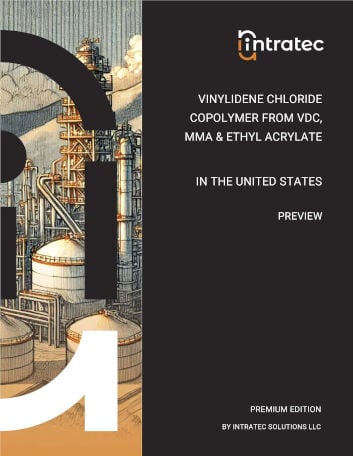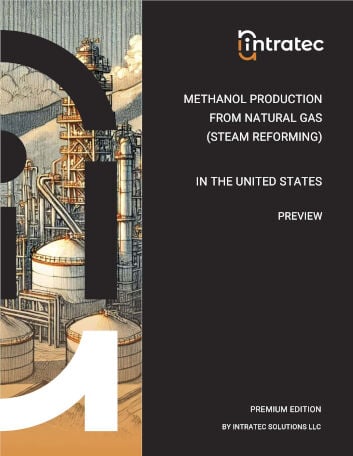Commodity Production Costs Report
Methyl Methacrylate Production from Isobutylene
Methyl Methacrylate Plant Capital & Operating Cost Analysis | United States | Q3 2025
This report presents the economics of Methyl Methacrylate (MMA) production from isobutylene using an oxidation process. The process examined is similar to Sumitomo/Nippon Shokubai process. In this plant, isobutylene is oxidized to methacrolein, which is further oxidized to methacrylic acid (MAA). Then, MAA is esterified with methanol to produce MMA.
The report provides a comprehensive study of Methyl Methacrylate production and related Methyl Methacrylate production cost, covering three key aspects: a complete description of the Methyl Methacrylate production process examined; an in-depth analysis of the related Methyl Methacrylate plant capital cost (Capex); and an evaluation of the respective Methyl Methacrylate plant operating costs (Opex).
The Methyl Methacrylate production process description includes a block flow diagram (BFD), an overview of the industrial site installations, detailing both the process unit and the necessary infrastructure, process consumption figures and comprehensive process flow diagrams (PFD). The Methyl Methacrylate plant capital cost analysis breaks down the Capex by plant cost (i.e., ISBL, OSBL and Contingency); owner's cost; working capital; and costs incurred during industrial plant commissioning and start-up. The Methyl Methacrylate plant operating costs analysis covers operating expenses, including variable costs like raw materials and utilities, and fixed costs such as maintenance, labor, and depreciation.

The process under analysis comprises 4 major sections: (1) Methacrylic acid (MAA) synthesis; (2) MAA Purification; (3) Methyl methacrylate (MMA) production; and (4) MMA purification.
MAA Synthesis. Initially, heated isobutylene is oxidized with air to methacrolein in the presence of a multicomponent oxide catalyst of Mo-Bi. The yield of methacrolein reaches over 80%. In addition to methacrolein, other oxygenated compounds by-products are formed. Then, the effluent is directly fed with air to another reactor, where methacrolein is oxidized to methacrylic acid with P-Mo heteropoly acid solution as catalyst.
MAA Purification. The effluent from MAA synthesis is directed to a quencher where most of the MAA condenses. The aqueous solution is routed to a solvent extraction unit, where the methacrylic acid is concentrated by extraction into dibutyl ketone organic solvent. The organic solution then fed to a column where it is dehydrated, yielding crude MAA, which is fed to a vacuum distillation column to obtain acetic acid as by-product.
MMA Production. MAA is fed with methanol to a reactive distillation column, where the esterification reaction takes place.The reaction occurs in the liquid phase, in the presence of an ion exchange resin as catalyst. Besides MMA, small amounts of by-products are formed. Heavy compounds withdrawn in column bottom are burned for fuel.
MMA Purification. The overhead stream of the reactor is fed to an extractor where it is contacted with water, in such a way that unreacted methanol is removed. A column strippes off water and low boiling impurities from the crude ester produced. Finally, components heavier than MMA are removed from the MMA stream in a rectifier. The column overhead vapor, consisting of high-purity MMA, is condensed and sent to storage.
Report in PDF Format
Download & Explore Anytime
Access in Various Devices
Print & Read Comfortably
Share With Co-workers
Up-to-date Report
Professional report based on Q3 2025 economic data, ensuring timely evaluations.
Multiple Use Cases
Ideal for investment screening, feasibility studies, cost estimates, and research planning.
Proven Methodology
Developed using a consistent methodology honed over a decade, ensuring reliable cost analyses.
Report Editions
Content Highlights
Plant Capital Cost Summary
Summary outlining the capital cost required for building the Methyl Methacrylate production plant examined.
Plant Capital Cost Details
Detailing of fixed capital (ISBL, OSBL & Owner’s Cost), working capital and additional capital requirements.
Plant Cost Breakdowns
Breakdown of Methyl Methacrylate process unit (ISBL) costs and infrastructure (OSBL) costs; plant cost breakdown per discipline.
Operating Costs Summary
Summary presenting the operating variable costs and the total operating cost of the Methyl Methacrylate production plant studied.
Operating Cost Details
Detailing of utilities costs, operating fixed costs and depreciation.
Plant Capacity Assessment
Comparative analysis of capital investment and operating costs for different Methyl Methacrylate plant capacities.
Production Process Information
Block Flow Diagram, descriptions of process unit (ISBL) and site infrastructure (OSBL).
Process Consumptions
Raw materials and utilities consumption figures, by-products credits, labor requirements
Process Diagrams
Process flow diagrams (PFD), equipment list and industrial site configuration
Other Methyl Methacrylate Production Cost Reports

Methyl Methacrylate Production from Acetone and Hydrogen Cyanide
This report presents the economics of a process similar to Evonik Aveneer for Methyl Methacrylate (MMA) production from acetone and hydrogen cyanide (HCN) in the United States. Initially, HCN purchased from external suppliers, acetone and methanol are used as raw materials for the production of MMA in six main steps, which are described in the report.
Details: 120 kta United States-based plant | Q3 2025 | 107 pages | Issue B | From $1,199 USD

Methyl Methacrylate Production from Acetone, NH3 and Natural Gas
This report presents the economics of a process similar to Evonik Aveneer for Methyl Methacrylate (MMA) production from acetone and hydrogen cyanide (HCN) in the United States. Initially, HCN is produced from ammonia (NH3) and natural gas in an on-site unit. Then, acetone and methanol are used as raw materials for the production of MMA in six main steps, which are described in the report.
Details: 120 kta United States-based plant | Q3 2025 | 107 pages | Issue C | From $1,499 USD

Methyl Methacrylate Production from t-Butanol
This study reviews the economics of a process for Methyl Methacrylate (MMA) production from t-Butanol. Initially, t-butanol is oxidized to metacrolein and then to methacrylic acid. Finally, the methacrylic acid undergoes esterification with methanol to generate MMA. The economic analysis performed is based on a plant constructed in the United States.
Details: 120 kta United States-based plant | Q3 2025 | 107 pages | Issue D | From $1,199 USD
Bundle & Save
Purchase multiple Methyl Methacrylate Production Cost reports and enjoy tiered discounts
up to 30% off!
Could Not Find the Report You Need?
Obtain a Bespoke Report
Get a report targeting the process in which you are interested
See Offer Details
Understand Bespoke Reports and how you can easily order them
Check Editions & Pricing
Complete a brief form and see a quotation for your Bespoke Report
Other Related Production Cost Reports

Methanol Production from Natural Gas (Combined Reforming)
This study presents the economics of large-scale Methanol production from natural gas in the United States. In this process, natural gas is first converted into synthesis gas (syngas) by means of conventional steam reforming and secondary autothermal reforming. Then, the syngas is converted into Methanol.
Details: 1700 kta United States-based plant | Q3 2025 | 107 pages | Issue B | From $799 USD

Vinylidene Chloride Copolymer from VDC, MMA & Ethyl Acrylate
This study presents the economics of Vinylidene Chloride Copolymer production from vinylidene chloride (VDC), ethyl acrylate, and methyl methacrylate (MMA) using an emulsion polymerization process. The economic analysis assumes a plant located in the United States.
Details: 45 kta United States-based plant | Q3 2025 | 107 pages | Issue B | From $799 USD

Isobutylene from Isobutane (Platinum-Catalyzed Dehydrogenation)
It presents the economics of Isobutylene production from isobutane in the United States, using a dehydrogenation process similar to UOP Oleflex. This technology uses a proprietary platinum dehydrogenation catalyst in a moving-bed reactor.
Details: 300 kta United States-based plant | Q3 2025 | 107 pages | Issue B | From $999 USD

Methanol Production from Natural Gas (Steam Reforming)
This study presents the economics of large-scale Methanol production from natural gas in the United States. In the process examined, natural gas is first converted into synthesis gas (syngas) by means of conventional steam reforming and then the syngas is converted into Methanol.
Details: 1000 kta United States-based plant | Q3 2025 | 107 pages | Issue A | From $799 USD

Isobutylene Production from Crude C4s
This study presents the economics of Isobutylene production from a crude C4s stream in the United States., using an extraction process similar to Total Isobutylene Acid Extraction process. In this process, sulfuric acid reacts with isobutylene to form an alcohol that is separated from the crude C4 raw material and, through a dehydration step, isobutylene is recovered.
Details: 60 kta United States-based plant | Q3 2025 | 107 pages | Issue A | From $999 USD
+800 Reports Developed, Targeting +250 Commodities
Vast Report Library
858 independent and up-to-date reports examining embryonic and established production processes.
Free Sample Reports
Quickly understand the structure and depth of content of our professional reports.

